Pneumoconiosis is a type of lung disease caused by inhaling coal dust particles that damages lung tissue over time with consistent exposure. Currently, there are 82 recorded cases of pneumoconiosis in Australia that have been linked to mining as the direct cause of the condition. Unfortunately, there are reports suggesting that there has been evidence of a spike in cases related to dust inhalation in the mining industry.
Cause of Dust Suspension
According to an academic paper written by Entwistle et al, “Dusts is released from a range of mining-related activities such as removal of the overburden, extraction and refining operations (e.g. smelter emissions; slag piles and tailings), and other ore-handling operations, all creating large volumes of dust that are readily mobilised by aeolian (wind-related) processes and can result in atmospheric transport over large distances.”
“Dust generation also occurs when transporting wastes, both on haulage roads within, and around, the mines, but also over longer distances such as along train lines. Widespread contamination associated with airborne emissions from active and legacy mining and smelting operations is well documented in the literature, reported across a wide range of sampled media, including attic dust; house dust; atmospheric dust; road dust; crop/vegetables; surface and groundwater, with mining-related particulates reported in soils adjacent to mines and across the towns of mining communities.” This was clearly seen in the rural Queensland case: Moranbah, which was discussed in a previous article released by GRT. Particles are also generated when the wind blows over bare ground and different types of stockpiles. These larger particles can have amenity impacts as well as health impacts. Fine particles from vehicle exhausts and mobile equipment are also produced at mine sites, though they only account for about 5 per cent of the particles emitted during the mining process.
Figure: According to the NSW Health, the following are the accepted definitions of the types of dust that can be found in and around mines. https://www.health.nsw.gov.au/environment/factsheets/Pages/mine-dust.aspx
Are environmental regulations, health and safety concerns or potential profit loss a concern right now?
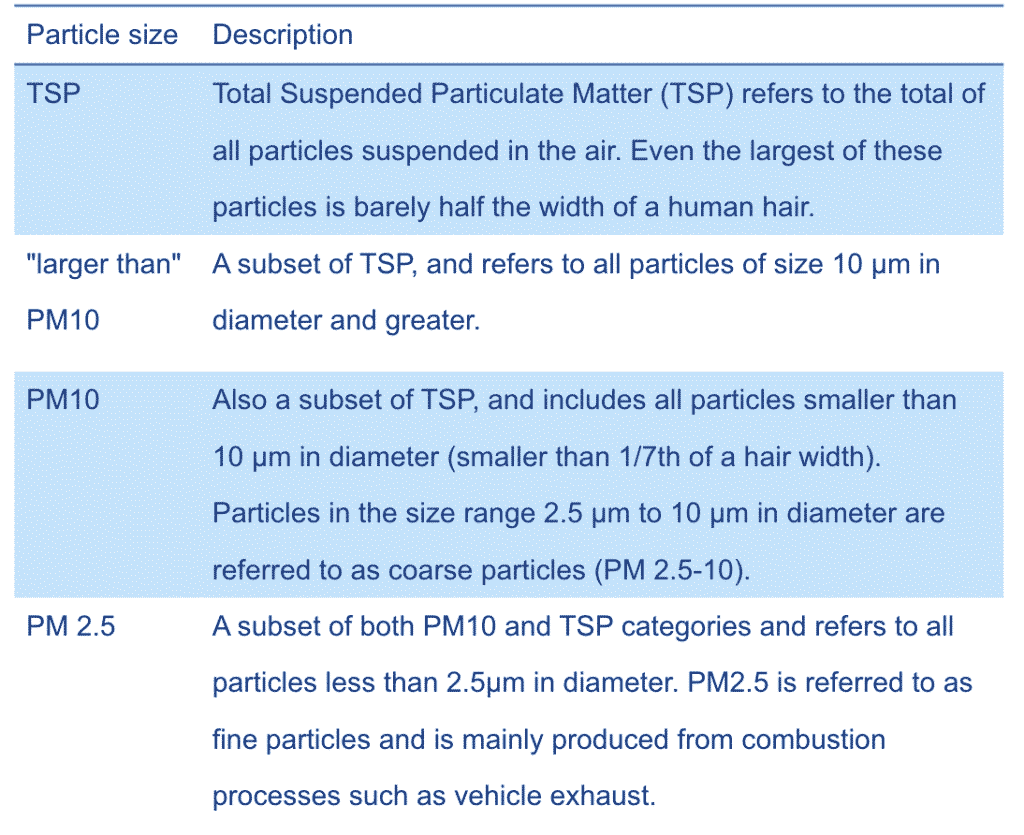 The vast majority of dust from mining activities consists of coarse particles (around 40 per cent) and particles larger than PM10, generated from natural activities such mechanical disturbance of rock and soil materials by dragline or shovel, bulldozing, blasting, and vehicles on dirt roads. The figure above defines the various dust sizes and types found in the mining industry. However, the question still stands as to why have we seen an increase in the number of cases over the last few years. One of the contributing factors may be the working hours of a miner. If we evaluate the work hours of workers, we see that the hours that miners are working in the last 50 years has dramatically increased. So it’s logical to assume that with an increase in work hours, there is a higher probability that miners are exposed to dust. This is reflected in the figure below.
The vast majority of dust from mining activities consists of coarse particles (around 40 per cent) and particles larger than PM10, generated from natural activities such mechanical disturbance of rock and soil materials by dragline or shovel, bulldozing, blasting, and vehicles on dirt roads. The figure above defines the various dust sizes and types found in the mining industry. However, the question still stands as to why have we seen an increase in the number of cases over the last few years. One of the contributing factors may be the working hours of a miner. If we evaluate the work hours of workers, we see that the hours that miners are working in the last 50 years has dramatically increased. So it’s logical to assume that with an increase in work hours, there is a higher probability that miners are exposed to dust. This is reflected in the figure below.
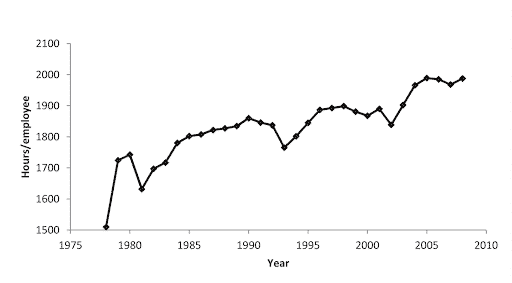 Figure: An increase in hours/employee in the mining industry over the last 50 years.
Figure: An increase in hours/employee in the mining industry over the last 50 years.
SHORT TERM HEALTH IMPACTS
When someone is exposed to dust they may develop minor symptoms, which can develop to serious conditions if exposure is continued. There is a range of short term impacts that can be signs of dust inhalation. If you or one of your employees show some of the following symptoms, there should be an immediate evaluation of the worksite environment. Some of the physical symptoms are:
- Consistent coughing
- Wheezing (post-work hours)
- Worsening of asthma symptoms
- Increased usage of medication-related to asthma such as puffers or antibiotics.
- Frequent Breathlessness
- High levels of TSP which can irritate eye or trigger sneezing episodes.
The human body’s respiratory system has a number of defence mechanisms to protect against the harmful effects of PM. However, the body is not built to withstand long terms of consistent exposure to dust. PM is often trapped in sticky mucus on the walls of the airways and can be removed by cilia, small hair-like objects which line the surface of the airways. This mucus can then be swallowed or coughed up.
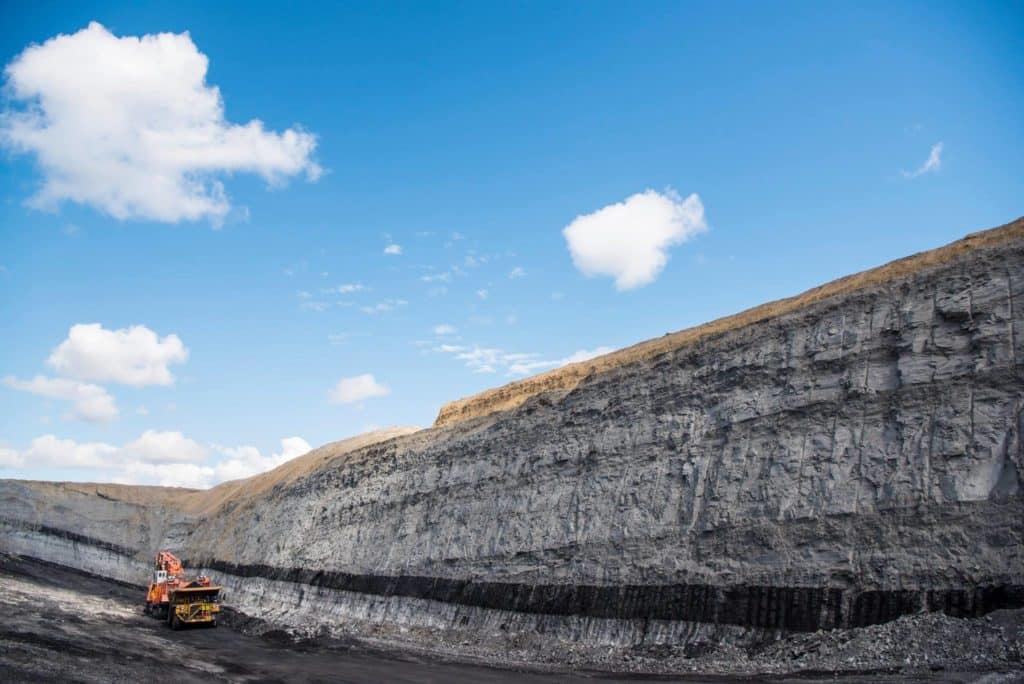
LONG TERM HEALTH IMPACTS
Studies link that high PM exposure can lead to increased hospital admissions and emergency room visits and even to death from heart or lung diseases. Both long (over years) and short term (hours or days). Generally, it is thought that fine particles below 2.5 μm in diameter is of a greater health concern than larger particles as they can reach the air sacs deep in the lungs. However, coarse particles (PM 2.5-10) could also be associated with adverse health effects. Some recent research suggests that heart problems, such as angina and heart attacks may also be associated with coarse particle pollution. Below is a summary of the health effects that may be triggered as a result of the dust that miners are exposed to in their workspace.
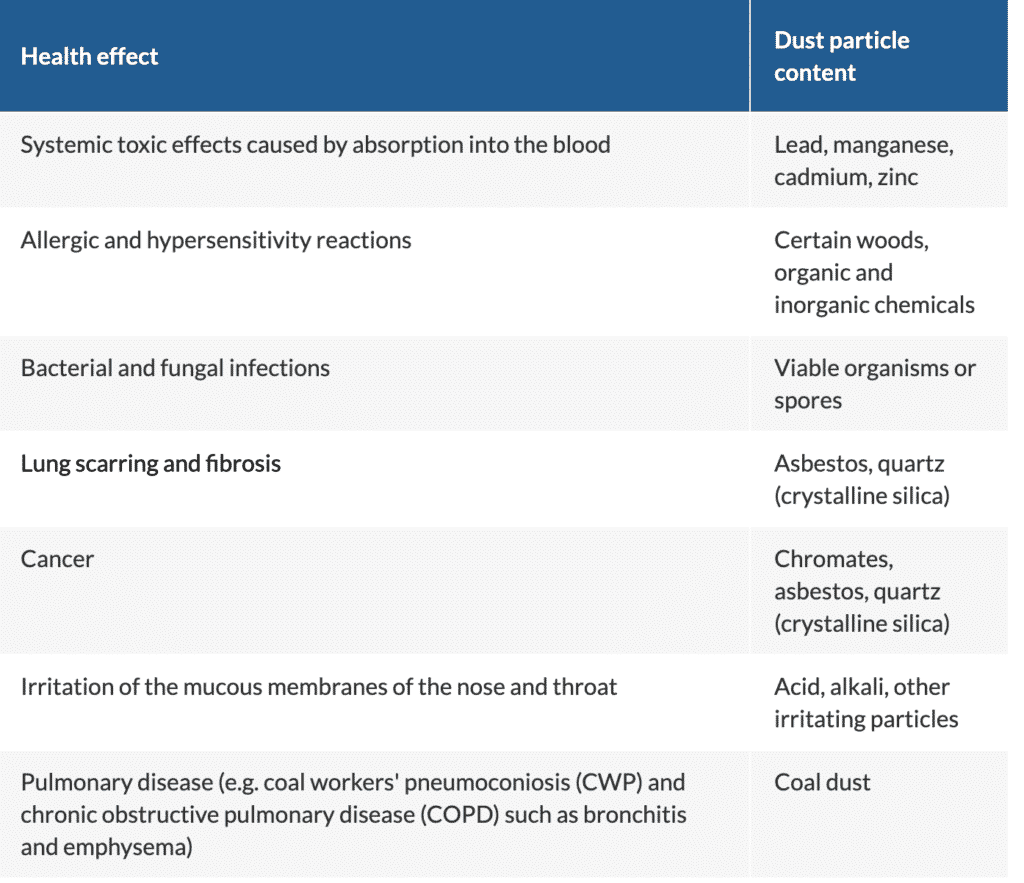
Figure: Summary of the health effect of dust on miners https://www.business.qld.gov.au/industries/mining-energy-water/resources/safety-health/mining/hazards/dust/health-safety
SUSCEPTIBLE POPULATION:
People who may be more susceptible to the health effects of fine and coarse particles are:
- infants, children and adolescents
- elderly
- people with respiratory conditions such as asthma, bronchitis and emphysema
- people with heart disease
- people with diabetes.
In a study conducted in the early 2000s, it was found that a large portion of miners in Australia does suffer from the excess weight ( overweight), many of these have been diagnosed with, or are on the lifestyle path towards having heart disease and/or diabetes. This further exacerbates the severity of the symptoms and effects of dust inhalation.
Figure: Current Air Quality Standards for Particulate Matter in an Australian Mining context https://www.health.nsw.gov.au/environment/factsheets/Pages/mine-dust.aspx
There have been calls for a re-evaluation of the levels and possibly tightening the dust exposure level laws due to the recent increase in dust-related diseases in mining in
Australia, which is presented in the figure above. However, little has been done to initiate the changes needed to protect the miners in the field. GRT offers a method of dealing with dust directly, without the need of waiting for the policy to change. The wide range of applications can be utilised across many disciplines and fields to control dust in the mining work environment. The cost-effective and efficient methods that GRT offer a long term solution to the problem that the government should have addressed years ago. Specifically, for quarries and mining, the following products are only a few of the many products offered by GRT to tackle dust suspension.
Haul -Loc
Haul – Loc is a liquid polymer that added to watering trucks used to reduce water required for continuous dust suppression. This ultra-concentrate uses GRT’s LCP technologies to improve the efficiency and effectiveness of water cart operations by up to 500%. Dust exposure, as a result, is limited for 4x-5x longer than utilising water alone. Save water, eliminate dust, and improve safety on your haul roads! Binds and creates a stable layer that is resistant to heavy traffic wear, wind erosion and rainfall impact. Specialised for long term projects and haul roads, due to its robust properties (non-toxic, biodegradable and dries completely odourless).
For more information: https://globalroadtechnology.com/grt-haul-loc/
GRT ACTIVATE UG
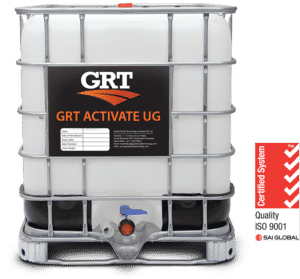 Is a product that was manufactured to directly target airborne dust faster than any other product that is currently available on the market. When water is utilised as a mitigation solution against coal, the chemical composition of water and coal causes them to repel each other on a molecular level. This makes it harder for the water to capture and trap the dust. What makes this product unique is all the properties it possesses, that places it as one of the most effective dust solutions in the industry. This product is water-resistant and is capable of being utilised in already existing spray systems. When it is added to water, it binds with water and improves the efficiency and capability of the water of capturing dust for extended periods of time. Once it is applied it dries completely odourless, non-hazardous and clear. When utilised against coal, it does not alter the combustible properties of the coal, and concentrates on only capturing the hazardous dust. It has been especially successful when used in drilling and gas extraction activities. This infers that less water is required to cover a large area, and once utilised over an area, the dust is trapped for an extended period of time. This product has been specifically engineered to be most effective in an underground mining environment for longwall operations, development mining and conveyor systems. After the product has been sprayed it is completely biodegradable and poses no threat to the environment after use.
Is a product that was manufactured to directly target airborne dust faster than any other product that is currently available on the market. When water is utilised as a mitigation solution against coal, the chemical composition of water and coal causes them to repel each other on a molecular level. This makes it harder for the water to capture and trap the dust. What makes this product unique is all the properties it possesses, that places it as one of the most effective dust solutions in the industry. This product is water-resistant and is capable of being utilised in already existing spray systems. When it is added to water, it binds with water and improves the efficiency and capability of the water of capturing dust for extended periods of time. Once it is applied it dries completely odourless, non-hazardous and clear. When utilised against coal, it does not alter the combustible properties of the coal, and concentrates on only capturing the hazardous dust. It has been especially successful when used in drilling and gas extraction activities. This infers that less water is required to cover a large area, and once utilised over an area, the dust is trapped for an extended period of time. This product has been specifically engineered to be most effective in an underground mining environment for longwall operations, development mining and conveyor systems. After the product has been sprayed it is completely biodegradable and poses no threat to the environment after use.
For more information: https://globalroadtechnology.com/grt-activate-ug/
GRT ACTIVATE
Is injected through existing spray systems, trucks or stabilizers, and targets hydrophobic fine dust. The key applications are for quarrying crushers and conveyors and for road construction. It lasts for approximately 12 months.
This cutting-edge dust control technology that makes water work better, harder, and more efficiently. This technology alone suppresses large and fine particles. The fine particles may not be visible to human eye, and are known as the most hazardous to health, and may lead to respiratory diseases, eye irritation and eye damage. These methods are able to control and suppress large, medium and fine particles, all of which are harmful to the human body. As shown above there are various products available through Global Road Technologies that suit different situations, environments and preferences.
With these effective technologies combined with the dust awareness habits mentioned in Table 1, you can go to work knowing your colleagues, employees and yourself are in a safe working environment.
For more information: https://globalroadtechnology.com/grt-activate/
WET-LOC
Wet – Loc is one of GRT’s latest and most innovative products that has only recently been released into the market.
 Composition: clear, synthetic fluid that is non-drying and non-setting, and sprayed directly onto roads, and areas of high traffic.
Composition: clear, synthetic fluid that is non-drying and non-setting, and sprayed directly onto roads, and areas of high traffic.
Mechanics: once the product is applied onto a road, it permeates into the top layer of the soil. The synthetic polymer attaches itself onto the soil particles within the top layer of the ground, and groups them together in a liquid structure that remains “wet” over the course of its use. It is extremely versatile in which materials it is capable of operating in, including gravel, sand, clay, limestone and most native soils. Due to its self-healing properties, it is capable of staying in this form and under intense pressure and stress from heavy vehicles for periods of up to 12 months. It is chemically formulated to withstand extreme weather conditions, eliminating any chances of evaporation and freezing. The material from which the product is formulated makes it non-flammable and non-volatile, removing any chances of combustion from friction or backfire from vehicles engines or tires. This product has primarily produced for the use of underground mining roads, areas of heavy damaging traffic, tracked machinery routes, forklift areas, container yards and even carparks.
For more information: https://globalroadtechnology.com/grt-wet-loc/
References:
-
- Entwistle A Jane, Hursthouse S Andrew, Reis Marinho A Paula, Stewart G Alex, 2019, Metallfierous Mine Dust: Human Health Impacts and the Potential Determinants of Disease in Mining Communities, Current Pollution Report, Volume 5, Pgs 67-83.
- https://www.cdc.gov/niosh/docs/2011-172/pdfs/2011-172.pdf
- https://www.business.qld.gov.au/industries/mining-energy-water/resources/safety-health/mining/accidents-incidents-reports/mine-dust-lung-diseases
- Department of Health and Human Services, 2011
Troy Adams
Troy Adams is the Managing Director of Global Road Technology (GRT) Specialising in Engineered Solutions for Dust Suppression, Erosion Control, Soil Stabilisation and Water Management. A pioneering, socially conscious Australian entrepreneur, Troy Adams is passionate about health and safety and providing innovative solutions that are cost-effective to the mining industry, governments and infrastructure sectors. Troy is also a tech investor, director of companies like Crossware, Boost, Hakkasan, Novikov and more.


